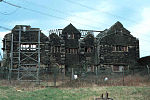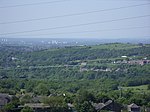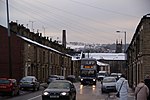Carrbrook

Carrbrook is a village east of Stalybridge, in Cheshire, Greater Manchester, England. The area still has many seventeenth and eighteenth-century buildings. Much of the late-nineteenth and the early-twentieth-century village was built during the industrial boom brought by the printworks. In the 1970s modern Housing estates were built next to the old village on the lower flank of Harridge Pike. The view to the east of Carrbrook is dominated by the steep-sided Buckton Hill, on the summit of which is located Buckton Castle. Neighbouring communities include Millbrook, Heyheads and Mossley. Many properties in Carrbrook were threatened by a large wildfire burning on Buckton Moor in late June 2018. The fires burned for several weeks and the damage caused is still visible to this day. On 26 June 2018, 50 properties in Carrbrook were evacuated as the fire advanced towards the settlement. Carrbrook is now part of a high fire risk zone. On the 27th December 2023 at approx. 23:10 GMT, a tornado hit the village during Storm Gerrit - the strongest in the UK since 2006. Heavy damage was done to some structures, however no deaths were recorded.
Excerpt from the Wikipedia article Carrbrook (License: CC BY-SA 3.0, Authors, Images).Carrbrook
Cheshire Road, Tameside
Geographical coordinates (GPS) Address Nearby Places Show on map
Geographical coordinates (GPS)
| Latitude | Longitude |
|---|---|
| N 53.5 ° | E -2.03 ° |
Address
Cheshire Road
Cheshire Road
SK15 3PS Tameside
England, United Kingdom
Open on Google Maps









